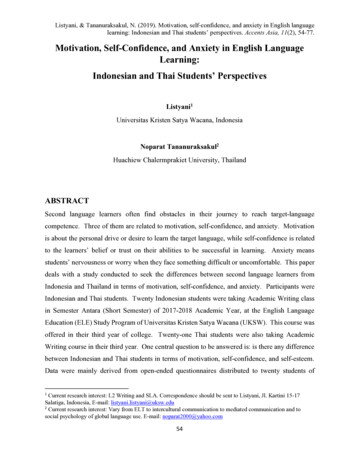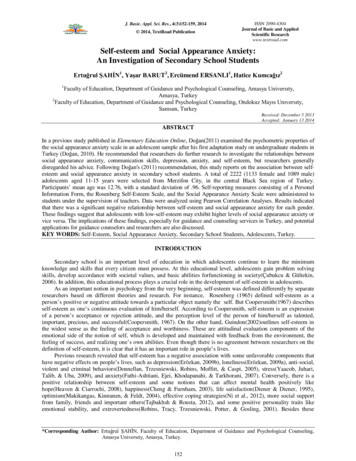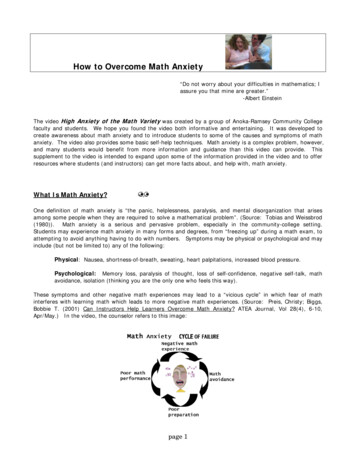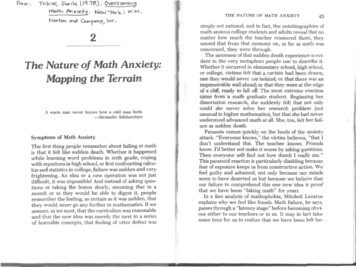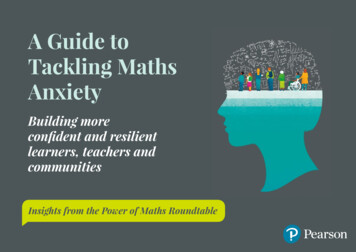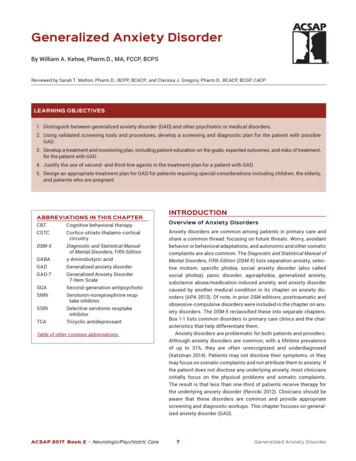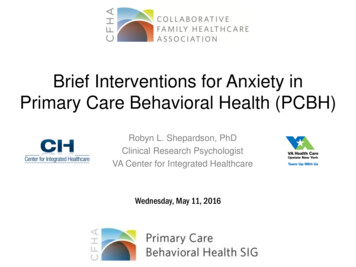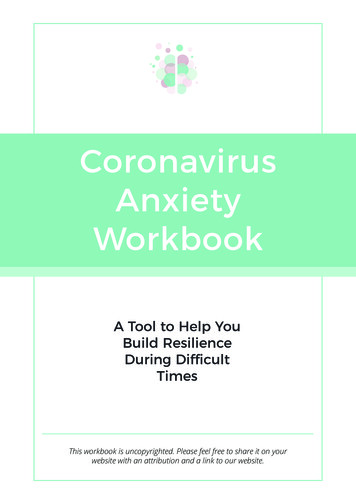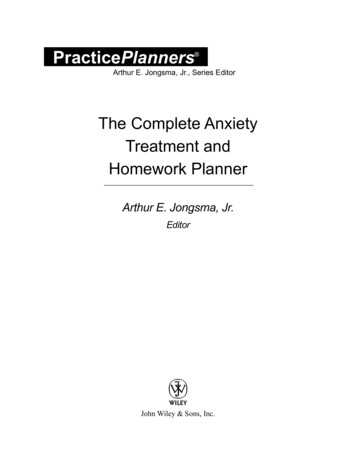
Transcription
PracticePlanners Arthur E. Jongsma, Jr., Series EditorThe Complete AnxietyTreatment andHomework PlannerArthur E. Jongsma, Jr.EditorJohn Wiley & Sons, Inc.
The Complete AnxietyTreatment andHomework Planner
PRACTICEPLANNERS SERIESTreatment TheTheTheTheTheTheTheTheTheTheTheTheTheTheComplete Adult Psychotherapy Treatment Planner, Third EditionChild Psychotherapy Treatment Planner, Third EditionAdolescent Psychotherapy Treatment Planner, Third EditionAddiction Treatment Planner, Second EditionContinuum of Care Treatment PlannerCouples Psychotherapy Treatment PlannerEmployee Assistance Treatment PlannerPastoral Counseling Treatment PlannerOlder Adult Psychotherapy Treatment PlannerBehavioral Medicine Treatment PlannerGroup Therapy Treatment PlannerGay and Lesbian Psychotherapy Treatment PlannerFamily Therapy Treatment PlannerSevere and Persistent Mental Illness Treatment PlannerMental Retardation and Developmental Disability Treatment PlannerSocial Work and Human Services Treatment PlannerCrisis Counseling and Traumatic Events Treatment PlannerPersonality Disorders Treatment PlannerRehabilitation Psychology Treatment PlannerSpecial Education Treatment PlannerJuvenile Justice and Residential Care Treatment PlannerSchool Counseling and School Social Work Treatment PlannerSexual Abuse Victim and Sexual Offender Treatment PlannerProbation and Parole Treatment PlannerPsychopharmacology Treatment PlannerSpeech and Language Pathology Treatment PlannerSuicide and Homicide Risk Assessment & Prevention Treatment PlannerCollege Student Counseling Treatment PlannerProgress Note PlannersTheTheTheTheTheTheTheChild Psychotherapy Progress Notes Planner, Second EditionAdolescent Psychotherapy progress Notes Planner, Second EditionAdult Psychotherapy Progress Notes Planner, Second EditionAddiction Progress Notes PlannerSevere and Persistent Mental Illness Progress Notes PlannerCouples Psychotherapy Progress Notes PlannerFamily Therapy Progress Notes PlannerHomework PlannersBrief Therapy Homework PlannerBrief Couples Therapy Homework PlannerBrief Adolescent Therapy Homework PlannerBrief Child Therapy Homework PlannerBrief Employee Assistance Homework PlannerBrief Family Therapy Homework PlannerGrief Counseling Homework PlannerGroup Therapy Homework PlannerDivorce Counseling Homework PlannerSchool Counseling and School Social Work Homework PlannerChild Therapy Activity and Homework PlannerAddiction Treatment Homework Planner, Second EditionAdolescent Psychotherapy Homework Planner IIAdult Psychotherapy Homework PlannerClient Education Handout PlannersAdult Client Education Handout PlannerChild and Adolescent Client Education Handout PlannerCouples and Family Client Education Handout PlannerDocumentation SourcebooksTheTheTheTheTheTheTheClinical Documentation Sourcebook, Second EditionForensic Documentation SourcebookPsychotherapy Documentation PrimerChemical Dependence Treatment Documentation SourcebookClinical Child Documentation SourcebookCouple and Family Clinical Documentation SourcebookContinuum of Care Clinical Documentation SourcebookComplete PlannersThe Complete Depression Treatment and Homework PlannerThe Complete Anxiety Treatment and Homework Planner
PracticePlanners Arthur E. Jongsma, Jr., Series EditorThe Complete AnxietyTreatment andHomework PlannerArthur E. Jongsma, Jr.EditorJohn Wiley & Sons, Inc.
This book is printed on acid-free paper.Copyright 2004 by Arthur E. Jongsma, Jr. All rights reserved.Published by John Wiley & Sons, Inc., Hoboken, New Jersey.Published simultaneously in Canada.No part of this publication may be reproduced, stored in a retrieval system, or transmitted in any form or by any means,electronic, mechanical, photocopying, recording, scanning, or otherwise, except as permitted under Section 107 or 108 of the1976 United States Copyright Act, without either the prior written permission of the Publisher, or authorization through paymentof the appropriate per-copy fee to the Copyright Clearance Center, Inc., 222 Rosewood Drive, Danvers, MA 01923, (978) 7508400, fax (978) 646-8600, or on the web at www.copyright.com. Requests to the Publisher for permission should be addressed tothe Permissions Department, John Wiley & Sons, Inc., 111 River Street, Hoboken, NJ 07030, (201) 748-6011, fax (201) 7486008.Limit of Liability/Disclaimer of Warranty: While the publisher and author have used their best efforts in preparing this book, theymake no representations or warranties with respect to the accuracy or completeness of the contents of this book and specificallydisclaim any implied warranties of merchantability or fitness for a particular purpose. No warranty may be created or extended bysales representatives or written sales materials. The advice and strategies contained herein may not be suitable for your situation.You should consult with a professional where appropriate. Neither the publisher nor author shall be liable for any loss of profit orany other commercial damages, including but not limited to special, incidental, consequential, or other damages.This publication is designed to provide accurate and authoritative information in regard to the subject matter covered. It is soldwith the understanding that the publisher is not engaged in rendering professional services. If legal, accounting, medical,psychological or any other expert assistance is required, the services of a competent professional person should be sought.Designations used by companies to distinguish their products are often claimed as trademarks. In all instances where John Wiley& Sons, Inc. is aware of a claim, the product names appear in initial capital or all capital letters. Readers, however, should contactthe appropriate companies for more complete information regarding trademarks and registration.All references to diagnostic codes are reprinted with permission from the Diagnostic and Statistical Manual of Mental Disorders,Fourth Edition, Text Revision. Copyright 2000. American Psychiatric Association.For general information on our other products and services please contact our Customer Care Department within the UnitedStates at (800) 762-2974, outside the United States at (317) 572-3993 or fax (317) 572-4002.Wiley also publishes its books in a variety of electronic formats. Some content that appears in print may not be available inelectronic books. For more information about Wiley products, visit our Web site at www.wiley.com.Note about Photocopy RightsThe publisher grants purchasers permission to reproduce handouts from this book for professional use with their clients.Library of Congress Cataloging-in-Publication Data:ISBN 0-471-64548-6Printed in the United States of America.10987654321
To my Dad, Arthur E. Jongsma, Sr., whose 95 year journey throughlife has been predominantly dedicated to serving his Lord to the bestof his ability. He loves the Lord and the Lord loves him.A.E.J.
CONTENTSPracticePlanner Series PrefaceIntroductionxv1SECTION I—Treatment Planning9Child13Arthur E. Jongsma, Jr., L. Mark Peterson, and William P. McInnisSchool-Based Child/Adolescent19Sarah Edison Knapp and Arthur E. Jongsma, Jr.Adolescent27Arthur E. Jongsma, Jr., L. Mark Peterson, and William P. McInnisAdult33Arthur E. Jongsma, Jr. and L. Mark PetersonAcute Inpatient Adult39Chris E. Stout and Arthur E. Jongsma, Jr.Addicted Adult/Adolescent45Robert R. Perkinson and Arthur E. Jongsma, Jr.Older Adult (Elderly)51Deborah W. Frazer and Arthur E. Jongsma, Jr.Employee59James M. Oher, Daniel J. Conti, and Arthur E. Jongsma, Jr.Medically Ill63Douglas E. DeGood, Angela L. Crawford, and Arthur E. Jongsma, Jr.Trauma Victim69Tammi D. Kolski, Michael Avriette, and Arthur E. Jongsma, Jr.Developmentally Disabled75Kellye H. Slaggert and Arthur E. Jongsma, Jr.Severely Mentally Ill83David J. Berghuis and Arthur E. Jongsma, Jr.xi
xiiTHE COMPLETE ANXIETY TREATMENT AND HOMEWORK PLANNERNeurologically Impaired91Michele J. Rusin and Arthur E. Jongsma, Jr.Conjoint Treatment of Anxiety99K. Daniel O’Leary, Richard E. Heyman, and Arthur E. Jongsma, Jr.Group Treatment of Anxiety107Kim Paleg and Arthur E. Jongsma, Jr.Group Treatment of Panic/Agoraphobia113Kim Paleg and Arthur E. Jongsma, Jr.Psychotropic Treatment of Anxiety121David C. Purselle, Charles B. Nemeroff, and Arthur E. Jongsma, Jr.Section II—Homework Planning and instructions for downloading fully-customizableassignments onlineChild127129Arthur E. Jongsma, Jr., L. Mark Peterson, and William P. McInnisExercise IIA.AExercise IIA.BExercise IIA.CExercise IIA.DAn Anxious StoryDixie Overcomes Her FearsMaurice Faces His FearShow Your StrengthsAdolescent131135141147151Arthur E. Jongsma, Jr., L. Mark Peterson, and William P. McInnisExercise IIB.AExercise IIB.BExercise IIB.CExercise IIB.DFinding and Losing Your AnxietyPanic Attack Rating FormTools for AnxietyWhat Makes Me AnxiousSchool153157161165169Sarah Edison KnappExercise IIC.AExercise IIC.BExercise IIC.C101 Ways to Cope with StressPhysical Receptors of StressReframing Your WorriesAdult171175179183Arthur E. Jongsma, Jr.Exercise IID.AExercise IID.BExercise IID.CAnalyze the Probability of a Feared EventFour Ways to Reduce FearPast Successful Anxiety Coping185191195
CONTENTSAddictionxiii199James R. Finley and Brenda S. LenzExercise IIE.AExercise IIE.BExercise IIE.CCoping with StressLearning to Self-SootheMy Anxiety ProfileEmployee201207211215Lise B. Mayers and Diana L. RabatinExercise IIF.AExercise IIF.BExercise IIF.CPanic Attack RecordTen Rules for Coping with PanicThe Process of Rational ThinkingGroup Anxiety217221223227Louis J. BevilacquaExercise IIG.AExercise IIG.BBeating Self-Defeating BeliefsWhat Happens When I Feel Anxious?Group Panic/Agoraphobia229233237Louis J. BevilacquaExercise IIH.AExercise IIH.BExercise IIH.CBreaking My Panic CycleWhat Else Can I Say or Do?When Is This Going to Happen?Appendix: Bibliotherapy Suggestions239243247251
PRACTICEPLANNERS SERIES PREFACEThe practice of psychotherapy has a dimension that did not exist 30, 20, or even 15 yearsago—accountability. Treatment programs, public agencies, clinics, and even group andsolo practitioners must now justify the treatment of patients to outside review entities thatcontrol the payment of fees. This development has resulted in an explosion of paperwork.Clinicians must now document what has been done in treatment, what is planned for thefuture, and what the anticipated outcomes of the interventions are. The books andsoftware in this PracticePlanners series are designed to help practitioners fulfill thesedocumentations requirements efficiently and professionally.The PracticePlanner series is growing rapidly. It now includes not only the originalThe Complete Adult Psychotherapy Treatment Planner, Third Edition, The ChildPsychotherapy Treatment Planner, Third Edition, and The Adolescent PsychotherapyTreatment Planner, Third Edition, but also Treatment Planners targeted to specialty areasof practice, including: addictions, juvenile justice/residential care, couples therapy,employee assistance, behavioral medicine, therapy with older adults, pastoral counseling,family therapy, group therapy, neuropsychology, therapy with gays and lesbians, specialeducation, school counseling, probation and parole, therapy with sexual abuse victimsand offenders, and more.Several of the Treatment Planner books now have companion Progress Notes Planners(e.g., Adult, Adolescent, Child, Addictions, Severe and Persistent Mental Illness,Couples). More of these planners that provide a menu of progress statements thatelaborate on the client’s symptom presentation and the provider’s therapeutic interventionare in production. Each Progress Notes Planner statement is directly integrated with“Behavioral Definitions” and “Therapeutic Interventions” items from the companionTreatment Planner.The list of therapeutic Homework Planners is also growing from the original BriefTherapy Homework to Adult, Adolescent, Child, Couples, Group, Family, Addictions,Divorce, Grief, Employee Assistance, and School Counseling/School Social WorkHomework Planners. Each of these books can be used alone or in conjunction with theircompanion Treatment Planner. Homework assignments are designed around eachpresenting problem (e.g., Anxiety, Depression, Chemical Dependence, AngerManagement, Panic, Eating Disorders) that is the focus of a chapter in its correspondingTreatment Planner.Client Education Handout Planners, a new branch in the series, provides brochuresand handouts to help educate and inform adult, child, adolescent, couples, and familyclients on a myriad of mental health issues, as well as life skills techniques. The list ofpresenting problems for which information is provided mirrors the list of presentingproblems in the Treatment Planner of the title similar to that of the Handout Planner.Thus, the problems for which educational material is provided in the Child andxv
xviPRACTICEPLANNERS SERIES PREFACEAdolescent Client Education Handout Planner reflect the presenting problems listed inThe Child and The Adolescent Psychotherapy Treatment Planner books. Handouts areincluded on CD-ROMs for easy printing and are ideal for use in waiting rooms, atpresentations, as newsletters, or as information for clients struggling with mental illnessissues.In addition, the series also includes TheraScribe , the latest version of the populartreatment planning, clinical record-keeping software. TheraScribe allows the user toimport the data from any of the Treatment Planner, Progress Notes Planner, or HomeworkPlanner books into the software’s expandable database. Then the point-and-click methodcan create a detailed, neatly organized, individualized, and customized treatment planalong with optional integrated progress notes and homework assignments.Adjunctive books, such as The Psychotherapy Documentation Primer, and Clinical,Forensic, Child, Couples and Family, Continuum of Care, and Chemical DependenceDocumentation Sourcebook contain forms and resources to aid the mental health practicemanagement. The goal of the series is to provide practitioners with the resources theyneed to provide high-quality care in the era of accountability—or, to put it simply, weseek to help you spend more time on patients, and less time on paperwork.ARTHUR E. JONGSMA, JR.Grand Rapids, Michigan
INTRODUCTIONSince the early 1960s, formalized treatment planning has gradually become a vital aspect of thehealth care delivery system, whether it is treatment related to physical health, mental health,child welfare, or substance abuse. What started in the medical sector in the 1960s spread into themental health sector in the 1970s as clinics, psychiatric hospitals, agencies, and other institutions,began to seek accreditation from bodies such as the Joint Commission on Accreditation ofHealthcare Organizations (JCAHO) to qualify for third-party reimbursements. With the advent ofmanaged care in the 1980s, treatment planning took on even more importance. Managed caresystems insisted that clinicians move rapidly from assessment of the problem to the formulationand implementation of a treatment plan. The goal of most managed care companies is to expeditethe treatment process by prompting the client and treatment provider to focus on identifying andchanging behavioral problems as quickly as possible. Treatment plans must be specific as to thepresenting problems, behaviorally defined symptoms, treatment goals, and objectives andinterventions. Treatment plans must be individualized to meet the client’s needs and goals, andthe observable objectives must allow for setting milestones that can be used to chart the client’sprogress. Pressure from third-party payors, accrediting agencies, and other outside parties hastherefore increased the need for clinicians to produce effective, high-quality treatment plans in ashort time. Because many mental health providers have little experience in treatment plandevelopment, our purpose in writing this book is to clarify, simplify, and accelerate the treatmentplanning process.PLANNER FOCUSCurrently, there are 28 Treatment Planners and 14 Homework Planners in the WileyPracticePlanners series. As the Series Editor, I have been privileged to work with many creativeand well-trained mental health professionals from around the country. Although these books havebeen written for implementation with a wide variety of treatment populations (e.g., adult,adolescent, child, older adult, addicted) or treatment settings (e.g., school, employment), somepresenting problems are common to many of our books. This book is a compilation of treatmentplanning and homework assignments focused on the presenting problem of anxiety.Various authors have approached the treatment of anxiety in specific client populations ortreatment settings. Some of the material has been modified slightly to make the style, length, andform uniform throughout the book. The authors of the individual chapters are cited in a footnoteat the beginning of each chapter. I thank them for their contributions to this book.The 25 homework assignments are grouped into eight categories based on their treatmentpopulation focus. If an assignment appears applicable to your client, you may visit the Wileywebsite www.wiley.com/go/completeplanners to download a full-size customizable version to1
2THE COMPLETE ANXIETY TREATMENT AND HOMEWORK PLANNERyour hard drive for current and future print out and distribution. You may download oneassignment at a time as it is needed or you may choose to download all 25 assignments in onevisit to the site.In the Treatment Planning section of The Complete Anxiety Treatment and HomeworkPlanner you will find a menu of statements to be included in outpatient and inpatient treatmentplans for a variety of client populations struggling with anxiety. There is no single bias to theObjectives and Interventions suggested, but rather you will find items reflecting an eclecticapproach of family therapy, individual therapy, pharmacotherapy, insight orientation, cognitiveand behavioral techniques, and others. The clinician may select those items from the menu thatbest fit his or her therapeutic approach and the client's individual strengths and needs.Each chapter of the Treatment Planning section contains a menu of items from which youmay select “Behavioral Definition” statements that describe your client’s symptom pattern,“Long-Term Goal” statements that describe the desired outcome of treatment, “Short-TermObjectives” statements describing observable steps toward the treatment goal, and “TherapeuticIntervention” statements describing suggested ways for you to help your client achieve theObjectives (as always, Intervention numbers are placed in parentheses after each Objective as away to suggest which Intervention may be most appropriate for the specific Objective). Finally,DSM-IV-TR “Diagnostic Suggestions” associated with the presenting problem are placed atthe end of each chapter.DEVELOPING A TREATMENT PLANThe process of developing a treatment plan involves a logical series of steps that build on eachother much like constructing a house. The foundation of any effective treatment plan is the datagathered in a thorough biopsychosocial assessment. As the client presents himself or herself fortreatment, the clinician must sensitively listen to and understand what the client struggles with interms of family-of-origin issues, current stressors, emotional status, social network, physicalhealth, coping skills, interpersonal conflicts, self-esteem, and so on. Assessment data may begathered from a social history, physical exam, clinical interview, psychological testing, or contactwith a client’s significant others. The integration of the data by the clinician or themultidisciplinary treatment team members is critical for understanding the client, as is anawareness of the basis of the client’s struggle. We have identified 6 specific steps for developingan effective treatment plan based on the assessment data.Step One: Client Population SelectionThe Complete Anxiety Treatment and Homework Planner assumes that the client is presentingwith anxiety as the primary or secondary problem. Choose the chapter that best reflects yourclient's population characteristics.Step Two: Problem DefinitionEach individual client presents with unique nuances as to how a problem behaviorally revealsitself in his or her life. Therefore, the anxiety problem requires a specific definition about how itis evidenced in the particular client. The symptom pattern should be associated with diagnosticcriteria and codes such as those found in the Diagnostic and Statistical Manual or theInternational Classification of Diseases. The Complete Planner, following the pattern established
INTRODUCTION3by DSM-IV-TR, offers behaviorally specific definition statements to choose from or to serve as amodel for your own personally crafted statements. A master list of behavioral definitionstatements describing anxiety can be found at the beginning of the Treatment Planning section.Symptom statements can be drawn from this list and applied to any of the various treatmentpopulations covered in the 17 treatment planning chapters. Additionally, each treatment planningchapter contains a few very specific behavioral definition statements that are uniquely applicableto the client population focused on in that chapter.Step Three: Goal DevelopmentThe next step in treatment plan development is to set broad goals for the resolution of the targetproblem. These statements need not be crafted in measurable terms but can be global, long-termgoals that indicate a desired positive outcome to the treatment procedures. Although theComplete Planner suggests several possible goal statements for each problem, one statement isall that is required in a treatment plan.Step Four: Objective ConstructionIn contrast to long-term goals, objectives must be stated in behaviorally measurable language. Itmust be clear when the client has achieved the established objectives; therefore, vague,subjective objectives are not acceptable. Review agencies (e.g., JCAHO), HMOs, and managedcare organizations insist that psychological treatment outcomes be measurable. The objectivespresented in this Complete Planner are designed to meet this demand for accountability.Numerous alternatives are presented to allow construction of a variety of treatment planpossibilities for the same presenting problem. The clinician must exercise professional judgmentas to which objectives are most appropriate for a given client.Each objective should be developed as a step toward attaining the broad treatment goal. Inessence, objectives can be thought of as a series of steps that, when completed, will result in theachievement of the long-term goal. There should be at least two objectives for the anxietyproblem, but the clinician may construct as many as are necessary for goal achievement. Targetattainment dates may be listed for each objective. New objectives should be added to the plan asthe individual’s treatment progresses. When all the necessary objectives have been achieved, theclient should have resolved the target problem successfully.Step Five: Intervention CreationInterventions are the actions of the clinician designed to help the client complete the objectives.There should be at least one intervention for every objective. If the client does not accomplishthe objective after the initial intervention, new interventions should be added to the plan.Interventions should be selected on the basis of the client’s needs and the treatmentprovider’s full therapeutic repertoire. This Complete Planner contains interventions from a broadrange of therapeutic approaches, including cognitive, dynamic, behavioral, pharmacologic,family-oriented, and solution-focused brief therapy. Other interventions may be written by theprovider to reflect his or her own training and experience. The addition of new definitions, goals,objectives, and interventions to those found in the Complete Planner is encouraged becausedoing so adds to the database for future reference and use.Some suggested interventions listed in the Complete Planner refer to specific books that canbe assigned to the client for adjunctive bibliotherapy. Appendix A contains a full bibliographic
4THE COMPLETE ANXIETY TREATMENT AND HOMEWORK PLANNERreference list of these materials. The books are arranged under each population for which theyare appropriate as assigned reading for clients. When a book is used as part of an interventionplan, it should be reviewed with the client after it is read, enhancing the application of thecontent of the book to the specific client’s circumstances. For further information about self-helpbooks, mental health professionals may wish to consult the Authoritative Guide to Self-HelpResources in Mental Health (2003) by Norcross, Santrock, Campbell, Smith, Sommer, andZuckerman (The Guilford Press, New York).Assigning an intervention to a specific provider is most relevant if the client is being treatedby a team in an inpatient, residential, or intensive outpatient setting. Within these settings,personnel other than the primary clinician may be responsible for implementing a specificintervention. Review agencies require that the responsible provider’s name be stipulated forevery intervention.Step Six: Diagnosis DeterminationThe determination of an appropriate diagnosis is based on an evaluation of the client’s completeclinical presentation. The clinician must compare the behavioral, cognitive, emotional, andinterpersonal symptoms that the client presents to the criteria for diagnosis of a mental illnesscondition as described in DSM-IV-TR. The issue of differential diagnosis is admittedly a difficultone that has rather low inter-rater reliability. Psychologists have also been trained to think morein terms of maladaptive behavior than in disease labels. In spite of these factors, diagnosis is areality that exists in the world of mental health care and it is a necessity for third-partyreimbursement. (Managed care agencies are more interested in behavioral indices that areexhibited by the client than in the actual diagnosis.) It is the clinician’s thorough knowledge ofDSM-IV-TR criteria and a complete understanding of the client assessment data that contribute tothe most reliable, valid diagnosis. An accurate assessment of behavioral indicators will alsocontribute to more effective treatment planning.HOW TO USE THIS PLANNEROur experience has taught us that learning the skills of effective treatment plan writing can be atedious and difficult process for many clinicians. It is more stressful to try to develop thisexpertise when under the pressure of increased client load and the short time frames placed onclinicians today by managed care systems. The documentation demands can be overwhelmingwhen we must move quickly from assessment to treatment plan to progress notes. In the process,we must be very specific about how and when objectives can be achieved, and how progress isexhibited in each client. The Complete Anxiety Treatment and Homework Planner was developedto aid clinicians in writing a treatment plan in a rapid manner that is clear, specific, and highlyindividualized according to the following progression:1. Choose the chapter that best reflects your client's population characteristics (Step One).Locate the corresponding page number for that population in the Complete Planner’scontents.2. Select two, three, or more of the listed behavioral definitions from the master list and/orthe unique statements applicable to the population to which your client belongs (StepTwo) and record them in the appropriate section on your treatment plan form. Add yourown defining statement if you determine that your client’s behavioral manifestation of theidentified problem is not listed.
INTRODUCTION53. Select one or more long-term goals (Step Three) and again write these selections, exactlyas written in the Planner or in some appropriately modified form, in the correspondingarea of your own form.4. Review the listed objectives for anxiety and select the ones that you judge to be clinicallyindicated for your client (Step Four). It is recommended that you select at least threeobjectives. Add a target date or the number of sessions allocated for the attainment ofeach objective, if necessary.5. Choose relevant interventions (Step Five). The Planner offers suggested interventionsrelated to each objective in the parentheses following the objective statement. But do notlimit yourself to those interventions. The list may offer options that are more tailored toyour theoretical approach or preferred way of working with clients. Also, just as withdefinitions, goals, and objectives, there is space allowed for you to enter your owninterventions into the Complete Planner. This allows you to refer to these entries whenyou create a plan around this problem in the future. You will have to assign responsibilityto a specific person for implementation of each intervention if the treatment is beingcarried out by a multidisciplinary team.6. Several DSM-IV-TR diagnoses are listed at the end of each chapter that are commonlyassociated with a client who has anxiety. These diagnoses are meant to be suggestions forclinical consideration. Select a diagnosis from those listed or assign a more appropriatechoice from the DSM-IV-TR (Step Six).Congratulations! You should now have a complete, individualized treatment plan that isready for immediate implementation and presentation to the client. It should resemble the formatof the sample plan presented on page 6.You may now proceed to the Homework Planning section that forms the last half of thisbook. Select from the homework assignments those that are most appropriate for assisting yourclient reach the treatment objectives. Each of the exercises may be customized after it
Psychotherapy Treatment Planner, Third Edition, and The Adolescent Psychotherapy Treatment Planner , Third Edition, but also Treatment Planners targeted to specialty areas of practice, including: addict


